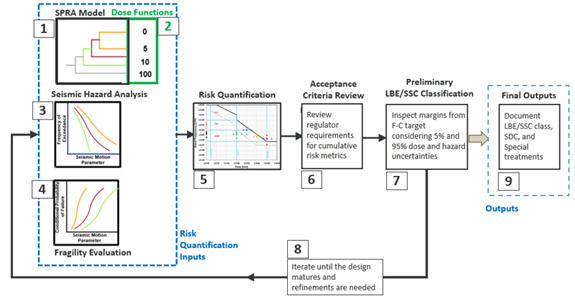The development of ANS standard for liquid-fuel molten salt reactors—ANSI/ANS-20.2-2023
Nuclear Safety Design Criteria and Functional Performance Requirements for Liquid-Fuel Molten Salt Reactor Nuclear Power Plants (ANSI/ANS-20.2-2023) has just been issued and is now available for purchase. It was developed by the American Nuclear Society and received approval from the American National Standards Institute (ANSI) on January 4.
ANSI/ANS-20.2-2023 provides nuclear safety design criteria for liquid-fueled molten salt reactor (MSR) nuclear power plants, including those that produce nonelectrical forms of power. The design criteria enable the development of reasonable assurance that liquid-fueled MSR plants are designed so that they can be operated without undue risk to the public health and safety or to the environment. This standard defines safety objectives, MSR design criteria, and definitions of MSR terminology important for safety evaluation.
This standard is intended to provide necessary guidance for designers to develop plant-specific liquid-fueled MSR principal designs based on the advanced reactor design criteria (ARDCs) provided by the Nuclear Regulatory Commission in Regulatory Guide 1.232, “Guidance for Developing Principal Design Criteria for Non-Light-Water Reactors,” and other regulatory requirements, while retaining the underlying safety principles of the ARDCs.
ANSI/ANS-20.2-2023 also provides general MSR-specific design criteria parallel to the sodium-cooled fast reactor and modular high-temperature gas reactor design criteria provided in RG 1.232, as well as an MSR-focused description of a risk-informed design process following the methodology endorsed in the NRC’s RG 1.233, “Guidance for a Technology-Inclusive, Risk-Informed, and Performance-Based Methodology to Inform the Licensing Basis and Content of Applications for Licenses, Certifications, and Approvals for Non-Light-Water Reactors.”
The development of this document was motivated by the renewed and growing interest in liquid-fueled MSRs, primarily among private organizations. Other, more detailed implementation standards are envisioned for detailed designs. Much of its structure follows the template developed in Nuclear Safety Criteria and Design Process for Sodium Fast Reactor Nuclear Power Plants (ANSI/ANS-54.1-2020). Two LWR counterparts—Nuclear Safety Criteria for the Design of Stationary Pressurized Water Reactor Plants (ANS-51.1-1973-N18.2 [withdrawn]) and Nuclear Safety Criteria for the Design of Stationary Boiling Water Reactor Plants (ANS-52.1-1978 [W1983])—were completed and approved much earlier (in 1971 and 1978, respectively). Those standards were subsequently updated in 1983, when new risk-based classifications were added.
Work on ANSI/ANS-20.2-2023 was initiated in 2015, and working group membership grew to include representatives of Idaho National Laboratory, Terrestrial Energy USA, Kairos Power, Framatome, the NRC, Southern Company, the University of Tennessee–Knoxville, Oak Ridge National Laboratory, Massachusetts Institute of Technology, the University of California–Berkeley, Flibe Energy, TerraPower, the Research Institute for Applied Science, the Thorium Energy Alliance, Advanced Systems and Tech Management, Exodys Energy, Argonne National Laboratory, the Electric Power Research Institute, the Korea Atomic Energy Research Institute, and the University of Illinois–Urbana-Champaign, as well as many consultants recognized for their subject-matter expertise. A table of contents and rough draft were developed by 2018, but the draft took many iterations before the working group was satisfied.
Finally in September 2021, the working group reached a consensus on a draft and began the internal committee review process within the ANS Standards Committee. The first step, considered to be a preliminary review, involves sending the draft out for review to the Advanced Initiatives Subcommittee and to other ANS committees with an interest in the draft standard. For ANS-20.2, this included the ANS Risk-informed, Performance-based (RIPB) Principles and Policy Committee, the Subcommittee on Risk Application (a joint committee with the American Society of Mechanical Engineers), and three consensus committees not responsible for development of this standard. In all, the draft standard received 50 specific comments—and considerably more suggestions.
Within three months, the working group had prepared responses to each comment and incorporated accepted changes into the draft. A few additional months were spent discussing responses with commenters. In the end, two comments remained unresolved, but the leadership decided to proceed with sending the draft standard to the Research and Advanced Reactors Consensus Committee (RARCC) for formal balloting. The RARCC ballot was issued in August 2022, with parallel public review through ANSI. Initially issued for a 60-day period, several extensions were required to give committee members sufficient time for review. The ballot eventually closed in October 2022 with more negatives than approvals and 40 more comments to be addressed.
The working group went back to their task, addressing and providing responses to each comment. This effort was completed by the end of February 2023. After much back and forth, the working group satisfied all but one objection, which was based on the lack of RIPB methods in the standard, per ANS’s recommended practice and as was the original intent when the project was initiated. After many discussions surrounding this issue, it was the consensus of the working group to leave the standard “as is” and not to delay the release of the standard to the industry.
As is required by ANSI, the draft was issued for a recirculation ballot to inform RARCC members of the maintained objection and to gain approval of substantive changes made to the draft. When the recirculation ballot closed September 2023 with only a few comments, the result was unchanged, in that the final tally included one maintained negative, which was reported to ANSI when their approval was requested. ANS’s top standards committee, the Standards Board, reviewed balloting process documents before requesting ANSI’s approval. (It should be recognized that one Standards Board member agreed with the maintained objection; the decision to seek ANSI approval was based on the consensus process, which does not require unanimous approval.) To purchase Nuclear Safety Design Criteria and Functional Performance Requirements for Liquid-Fuel Molten Salt Reactor Nuclear Power Plants (ANSI/ANS-20.2-2023), visit the ANS Online Store.




